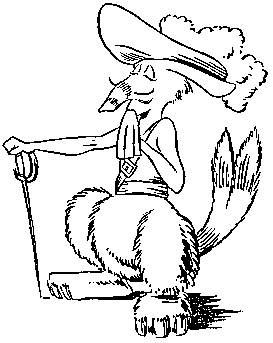October in Essen
Pevans reports from Spiel '19
This is my report from the 2019 Spiel games fair in Essen, Germany. It is written as a narrative, to be read through from the start, but you can also use the links below for the list of exhibitors, list of games and sections of the report.
- List of Exhibitors
- List of Games
- Introduction
- Preview night (Wednesday)
- The hordes arrive (Thursday)
- Games, beer and pig's knuckle (Friday)
- If it's that crowded, it must be Saturday
- Saving the best (?) 'til last (Sunday)
It is also available as a PDF document: Spiel '19 report (10 Mb). (You will need Adobe Reader to view this document – use the link to download it if necessary.)
List of exhibitors
This list is the exhibitors I mention in the report: click on the name to go to that section.
| Name |
|---|
| 999 Games |
| BGNations |
| Devir |
| Grey Fox Games |
| Irongames |
| Lautapelit |
| Martin Wallace Designs |
| MEBO Games |
| Osprey Games |
| Name |
|---|
| Pegasus (demo night) |
| PSC Games |
| Quick Simple Fun Games |
| Quined Games |
| R&R Games |
| Sit Down! |
| Stronghold Games |
| Tasty Minstrel Games |
List of games
This list is links to my notes on the games I saw and played during the show.
| Title | Publisher |
My rating* |
|---|---|---|
| Adventure Island | Pegasus Spiele | 7* |
| Amul | Lautapelit | 9 |
| Blitzkrieg! | PSC Games | 8 |
| Bloodstones | Martin Wallace Designs | 8* |
| Bushido | Grey Fox Games | 6* |
| Carrossel | MEBO Games | 6* |
| Chicago 1875: The City of Big Shoulders | Quined Games | 9** |
| Coralia | R&R Games | 6* |
| Dawn of Mankind | Tasty Minstrel Games | 9 |
| De Stijl | Quick Simple Fun Games | 4* |
| Humboldt's Great Voyage | R&R Games | 8* |
| La Viña | Devir | 6* |
| Die Macher | Spielworxx | - |
| Meeple Circus | Matagot | 4* |
| On the Underground (2nd ed) | Ludicreations | 9 |
| Pact | Irongames | 7* |
| Paris: La Cité de la Lumière | Devir | 7* |
| Porto | MEBO Games | 6* |
| Potemkin Empire | Stronghold Games | 7* |
| Rome & Roll | PSC Games | - |
| Tiny Towns | AEG | 7* |
| Tricky Druids | Pegasus Spiele | 6* |
| Undaunted: Normandy | Osprey Games | 8* |
| Western Empires | 999 Games | - |
| Wormlord | Sit Down! | 9 |
| Yin Yang | BGNations | 9* |
| * Provisional rating, based on playing once ** Enthusiasm rating, based on a demo |
||
Introduction
I decided to fly to Germany for this year's Spiel games fair, something I haven't done for a few years. The trip was just as I remembered it: fly to Düsseldorf, 'Skytrain' to the mainline train station and train to Essen's Hauptbahnhof (main station). As our usual haunt, the Hotel Jung, is closed for refurbishment this year, my usual room-mate, Peter Card, and I were in the InterCity Hotel - a short walk from the Hauptbahnhof. This turned out to be a well-appointed modern hotel with a function room set aside for games in the evening.
It's also easy to get to the Messe (exhibition halls) from there. Take the U-11 underground train (though the actual vehicle is more like a tram) from the main station. It's a short ride, but there is a big crowd trying to get on each train in the morning. Extra services mean it's just a matter of being patient. The grand new East entrance is now open at the Messe and this was the main way in, especially for those buying tickets on the day. My press pass meant I could stroll in through the relatively quiet West entrance - though it's an extra stop on the U-bahn.
I had better give my usual disclaimer about this report. Spiel is too big for one person to see everything (something I used to try to do), even over four days. Hence this report consists of my highlights which, by definition, will be different from everybody else's. For a start, I know I didn't go down every aisle in every hall and there were major publishers I didn't get to look at. I continued my policy of recent years of sitting down and trying games (rather than just listening to the marketing pitch) and these are (mostly) what I'll report on.
Preview night (Wednesday)
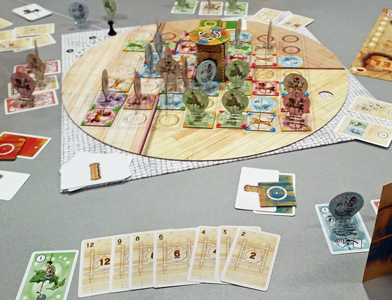
Carrossel in play with riders on the three-section roundabout
I actually started on Wednesday evening, before the fair formally opens, with the preview night run by the organisers (Friedhelm Merz Verlag). This was their first such event, with the aim of letting people get an early look at some of the new games. I had the company of David Chapman for the evening, playing games together for the first time in several years. The event was spread over three rooms with a games library in one and some publishers demonstrating their games on specific tables.
David and I gravitated to Portuguese publisher MEBO Games, who produced Viral a couple of years ago (and many others before and since). They had a couple of colourful games to try and we started with Carrossel (designed by Antonio Sousa Lara, co-designer of Viral). This features a merry-go-round, of course: a cardboard disc in the centre of the board which you rotate. We were joined by a German gamer, so were using the three-player side of the disc. This has a square grid divided into three sections, with each section separately numbered.
Players have a set of numbered cards and use these to place coloured tiles onto the matching position on their current disc section. When you make three in a row that matches the colours of the cards in front of you, you place riders on the squares on the disc and give the cards to the players whose tiles you've just covered. The cards are worth points at the end of the game or can be used during play for a benefit - such as taking back your number cards so that you can play anywhere again (your options get increasingly limited as the game goes on).
To add a bit of strategy, there are also goal cards that score at the end but can be worked towards from the beginning - these points did me very nicely in our game. Carrossel is clearly intended as a family game, given the colourful components and friendly theme, but is actually very tactical. Not least because the board turns between rounds. There's definitely something in the game to appeal to gamers, too, but it didn't really grab me. I give it a provisional 6/10 on my highly subjective scale.
MEBO's second game, Porto (designed by Orlando Sá), was even more colourful and looked more complex. The board shows a colourful waterfront scene of the city of Porto (centre of the Port trade, of course) with spaces for players to fill in with colourful buildings, storey by storey, positions for the colourful cards players will draft and a rather dull scoring track around the edges.
Play is simple: take cards or play cards. Playing cards adds storeys (little rectangular tiles) to a building and scores points, with extra points for adjacent tiles, matching bonus cards and for starting (a storey with a door) and finishing (a triangular roof tile) a building. The roof tiles also govern the length of the game, triggering the final round when enough of these have been placed (depending on the number of players).
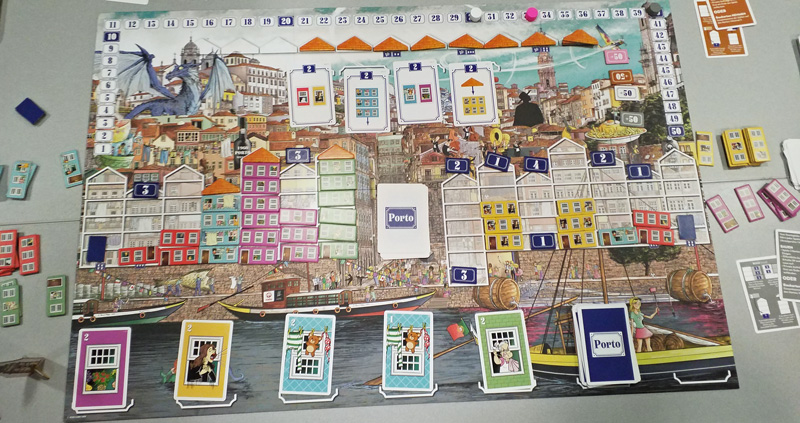
Here's Porto with three buildings completed so far (spot the triangular orange roofs)
As well as the bonus cards that give you points for specific actions on your turn there are end-game goals that players can work towards through the game. Our game started simply enough: take a few cards, add some buildings. However, it quickly became a mess of tactical options and tricky decisions - especially when you work out what your opponents are up to. Porto is quick-playing tactical fun, nicely illustrated and very colourful. It gets a provisional 6/10 on my highly subjective scale.
Next up, David introduced me to one of his favourite new games, Tiny Towns - designed by Peter McPherson and published by AEG. This looked simple enough. One player chooses a resource (coloured cube), and everybody places one of these on the square grid of their board. If the colours and the polyomino shape they make match one of the building cards, remove the cubes and place that building (nice wooden piece) in one of the just-vacated spaces on your grid.
As you play the game, it quickly becomes apparent how much placing stuff limits your options. I want to put this building there, which means laying out this set of cubes. But I've got to wait for the right cubes, so I'll start a different building next to it. Except now I don't have space to do both. Aagh! And as the game goes on, space gets more limited and empty squares are left between buildings.
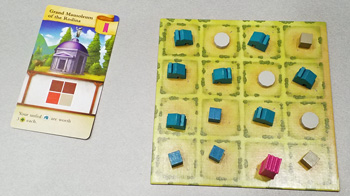
A winning position in Tiny Towns!
The game ends once one player has filled their board, so there's also a race element. Each building scores in a different way according to what other buildings are next to it or on that board (or not). Hence the game is different according to what mix of buildings is being used. My 'monument' building (red) meant I scored points for my villages (blue) without needing 'farms' (to feed them). I built lots of them, interspersed with the odd 'well' (white discs) and won by a point! Despite my simple strategy, it's tricky tactical stuff. I'd like to try it with more players and it gets a provisional 7/10 on my highly subjective scale.
Returning the favour, I introduced David to the new edition of On the Underground (designed by Sebastian Bleasdale and re-published by Ludicreations). We set up the London board, despite the two German guys who joined us later ("I live in Berlin," asserted one of them, who fancied playing on the other side of the board) claiming this gave us an advantage. It's been a while since I played the game, but I didn't spot any major differences from the original.
Depending on the number of players, each has wooden 'sticks' in several colours and plays them to extend their underground/unterbahn lines along the pre-printed routes on the board. There are points for connecting to various targets on the map, but most points come from moving the 'Passenger' pawn. The Passenger will move to one or two stations at the end of every player's turn. Yes, every player's turn. The pawn's movement is governed by a couple of simple rules and players score a point each time he uses one of their lines.
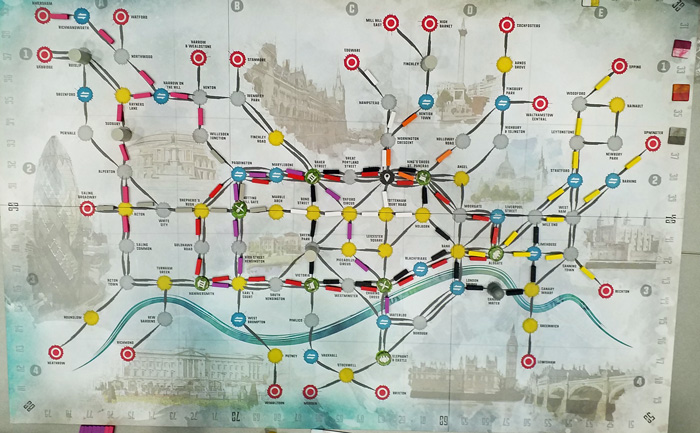
Playing the new edition of On the Underground – and that's definitely London
So the immediate thought is to build a line where the Passenger must use it. Except that, once you've started them all, you can only extend your lines from where they are. Hence there is value in keeping track of where the Passenger has yet to go and extending into those areas. On the London board it's also possible to get a substantial bonus for completing a loop of track that encloses other stations.
On the Underground is quite a cerebral game (I blame Sebastian), but is still good fun. I won this particular game by the tried and tested strategy of building the Circle line (in red on the photo) to enclose lots of central stations (this usually only works against beginners, by the way). The Berlin map has the same basics, but different bonuses, and the whole package is nicely produced. It remains a 9/10 on my highly subjective scale.
We wrapped up at this point, catching the last U-bahn of the evening into the city centre, rather than sticking it out to 1 am and the promised shuttle buses. Well, it's the first night, so you've got to pace yourself... or maybe I'm getting old. :-)
The hordes arrive (Thursday)
Thursday is when Spiel officially starts and the hordes of gamers waiting for the doors to open are eager to collect their advance orders and be first to play/buy the exciting new games. I seem to have a relaxed Thursday. I certainly didn't make too many notes on what I did. Of course, there were things to collect and people to say hello to...
I definitely looked at the new edition of Die Macher as I have fond memories of playing the original (it has a nicely cynical view of politics with parties amending their policies to fit the public's fads and spending as much money as they can lay their hands on). Veteran designer Karl-Heinz Schmiel seems to have been well served by the new publishers, Spielworxx and Stronghold as the latest edition looks splendid. And I'm told that gameplay remains pretty much the same, though it has been streamlined a bit.
999 Games had something called Western Empires on display. "That looks a lot like Civilization," I thought. And so it does: it's a cut-down version of Mega-Civilization (see my report from Spiel '15). Designed by Flo de Haan, Gerart de Haan and John Rodriguez from Francis Tresham's original Civilization, the mega game was a monster for up to 18 players and published as a limited edition (in a hefty wooden box). Western Empires is closer to the original game, supporting 5-9 players on a map centred on the Mediterranean and taking only 6-12 (!) hours to play. It looks good, but I'm more likely to stay with the Gibsons edition of the original, which was re-published last year.
Linking up with my roommate, Peter Card, we headed in the direction of PSC Games to see what was new and say hello to Will Townshend and the rest of the team. Their new game is Blitzkrieg!, which particularly interested me because it's designed by Paolo Mori, even though it's a two-player game. There'll be more about this one later on. The prototype on show was David Turczi's Rome & Roll, which I rather dismissed at the UK Games Expo earlier in the year. However, taking a closer look reveals a more interesting game.
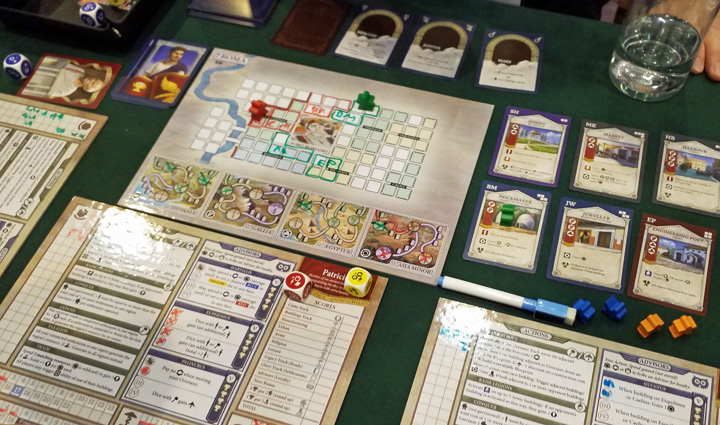
A demo game of Rome & Roll in progress
Players draft dice from those rolled at the start of the round. They spend these to carry out actions in the game - though some actions don't require dice. Players collect resources, construct buildings, conquer provinces and build roads. The buildings are polyomino shapes drawn onto the central board as the players re-build Rome after the great fire. This is definitely worth trying out. It was successfully funded on Kickstarter at the beginning of November and we can expect the finished game next May.
Also to come from PSC is a new multi-player wargame from Martin Wallace, whose stand (as Martin Wallace Designs) was just across the aisle. Now titled Bloodstones (its former working title was Runestones), the game equips its players with sets of domino-style blocks. These are tailored to give each faction its own strengths and weaknesses. Peter (Giants) and I (Humans) sat down to try it with a German couple (playing the Necromancer and ... something else).
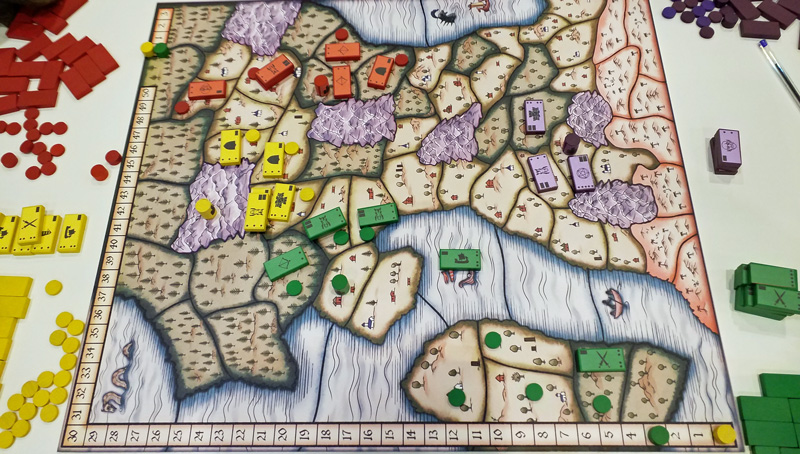
Bloodstones: my Humans (green) are defending their villages against Peter's Giants (yellow) – though he's got red to worry about too
Not only are the blocks players' units, but they're also how you pay for doing things. Thus, putting a new unit on the board means discarding blocks. So does moving pieces, though movement is paid for using the dots shown on (one edge of) the blocks, so one block can pay for moving several pieces. Blocks are also deployed to add their dots to player's combat strengths, so you have to think about how you want to use your blocks.
However, it's villages (discs) you score points for, so I built lots of villages with a big enough military force to hold off the others (I'm green in the photo). At first acquaintance, Bloodstones is an interesting game with some intriguing tactical options. However, it is very much a wargame, which some will find off-putting, and there's a substantial luck element, too. It gets a provisional 8/10 on my highly subjective scale.
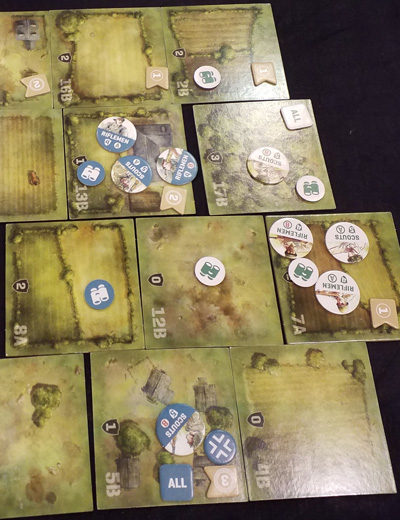
Playing Undaunted: Normandy – I've thrown my troops forward to grab points
Peter and I found another wargame at Osprey Games: Undaunted: Normandy. Designed by Trevor Benjamin and David Thompson, this is a skirmish scale, two-player wargame powered by a deck-building mechanism. Except that it's also a deck-destroying mechanism. Thus each player has their own deck of cards from which they draw their hand. They play cards from hand to move their soldiers (cardboard counters) on the board (built from large square carboard tiles that provide plenty of variety) and attack.
In addition, players can (and sometimes must) add cards to their deck, including 'fog of war' cards that limit players' actions. Adding a card for a particular soldier means more opportunity to use that counter. What's more, when a soldier is hit, you throw away ("trash" in the jargon) a card, only removing the counter from the board once you've run out of cards. Thus more cards means more hit points, so to speak.
We played the basic scenario, which just involves riflemen and scouts fighting over a few victory point markers. I drew German, so I started with some points, putting the onus on Peter to attack. We both advanced to our left, but Peter then had to backtrack to stop me getting the winning points. We churned through our cards in a really tough fight for those points. I won, but it seemed I had quite a head start. The other scenarios make things more complicated and bring in other weaponry (machine guns, mortars et al). This is another game I'd like to explore more, despite it only being two-player. It gets a provisional 8/10 on my highly subjective scale.
Thursday evening was the game night organised by distributor and publisher Pegasus. This has been good fun in previous years, but I found it a bit disappointing this year. Unlike previous years, when the event has taken place on Pegasus's stand in the main halls, it followed the format of the previous day's preview night and took place in the same three rooms downstairs. Peter and I were joined by our long-term gaming buddy John Mitchell, but found that all the heavier games - and Pegasus demoers - had been grabbed before we got into the main room.
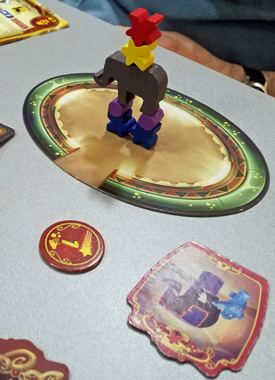
There wasn't much of interest left on the 'library' shelves either, so we ended up with Meeple Circus (designed by Cédric Millet and published by Matagot), which was at least something we hadn't played. To begin with, it was entertaining as you have to balance different meeples (animeeples too!) in odd positions to score points. The tactical bit is that you have to get both the scoring card and the meeples in order to score, but can only take one at a time. This gives plenty of scope to mess with the other players.
The game degenerated in the third 'act' when the requirement for forfeit-style actions appeared. Oh dear. The other handicap is that you need the app on your phone to get the random (I presume) timing for each round. With terrible reception in the downstairs rooms and no wi-fi, we just took as long as we needed. I'm sure it's great fun in the right company, but I'll be steering clear of it. It gets a provisional 4/10 on my highly subjective scale.
John then found a copy of Tricky Druids for us to try. Designed by Carlo Rossi and published by Pegasus themselves, this is a dice-drafting game. Players are collecting the symbols they need to complete their (hidden) potion recipe. They roll dice to get symbols and then take some of them. The twist is that they must first offer the dice to another player, which suddenly makes the game much more interesting.
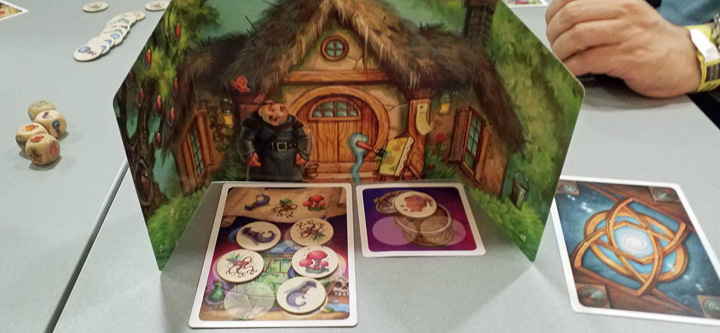
My Tricky Druids holdings: I need one more ingredient for my second potion
So, do you offer stuff you want, in the hope that the other will refuse them? Only if refused can you take them and add them to your potion. The other issue is that any dice you take that you can't use must go onto your 'bin' card. If your bin overflows, you lose everything you've collected so far. Eek! So, do you offer what you hope is a poisoned chalice, so to speak? After a couple of turns you begin to get an idea of what the others might be collecting, which adds to the decision-making. Or have they been bluffing? Or double-bluffing?
This is a neat enough family-orientated game, but less interesting when three hardened gamers are playing. I suspect another player would improve things, providing more options for who to give things to. Peter was first to put too much into his bin, which set him back, and John romped to victory. Tricky Druids gets a provisional 6/10 on my highly subjective scale.
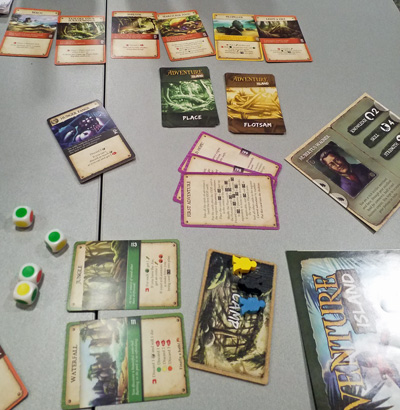
Our game of Adventure Island in progress
Our next find was Adventure Island, another Pegasus publication, designed this time by Michael Palm and Lukas Zach (the guys behind the rather clever Undo series). This is a card-based co-operative game of surviving after being shipwrecked on a Pacific (?) island. Each player has their own character with a specific skill and can carry out two actions per turn. First, you need to find food and shelter... "Hang on," I said, "this is just like Robinson Crusoe". And so it was. A simplified Robinson Crusoe, to be sure (there's no hunting mechanism, for example), but very much the same game - which is one of my favourite co-operative games.
Anyway, we pootled through the first scenario, feeling confident of achieving its goals. Then the deck ran out. "Shuffle discards and continue?" I queried. No: we'd lost. Oops! The time pressure is vicious. Reviewing what we'd done, we reckon it is possible to complete the scenario, but you have to focus on the goals right from the start. A few wasted actions and you're done for. If I've got the rules right, the game is actually easier with four players: you have the same number of rounds, but the extra person means two more actions each time. Bizarre.
As a Robinson Crusoe fan I quite enjoyed this and would like to give it another go - probably with four players. For the time being it gets a provisional 7/10 on my highly subjective scale. And that was the end of our evening: time to find a taxi back to our hotels (the U-bahn having stopped a couple of hours earlier).
Games, beer and pig's knuckle (Friday)
Peter and I decided to start in hall 2 on Friday and gravitated to R&R Games to say hi to Frank DiLorenzo and the rest of the gang. Two of their games caught our attention and we sat down to try them.
The first, Coralia, was designed by Michael Rieneck and the German version is published by HUCH!. It is definitely a game with brightly coloured pieces. Starting with the translucent dice: players rolling four of these and then choose one to place on the board. It goes on a specific 'reef', according to its colour, and a specific space, matching the symbol shown. The next player gets the remaining dice, adds a fourth and rolls them all. Thus only the colour of the dice is passed on. Since there's generally only one position on the board for each colour + symbol combination, things get tricky towards the end of the game - though there is compensation if you can't place a die.
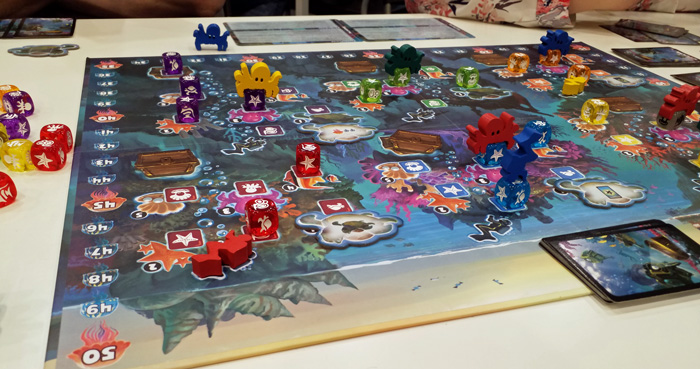
Playing Coralia – did I mention that it's colourful
Most of the symbols mean that you pick up cards of that type when a place a die. These score points at the end of the game in different ways: each oyster has a points value, for example, while fish score according to how many you've got of that type. Other symbols let you do things on the board - like taking a treasure chest for a bonus of some kind. While it seemed quite straightforward at the start, it quickly got tricky, especially as I tried to build on earlier turns by collecting more of the same.
I found Coralia a fairly light game, though with some clever tactical options. However, your options can be limited and there's noticeable downtime between turns. It gets a provisional 6/10 on my highly subjective scale.
The second game looked much more our cup of tea: Humboldt's Great Voyage was designed by Remo Conzadori and Nestore Mangone (and the German version again comes from HUCH!). Most of the board shows large circles, named for major ports around the world, with arrows showing the connections between them. Once the circles are stocked with cardboard chips, this becomes a Mancala mechanism that is central to the game.
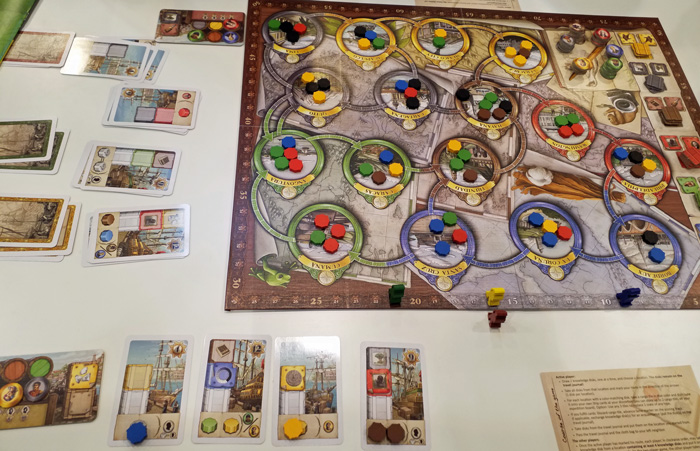
Humboldt's Great Voyage in play with my current ships bottom left
Players draw a chip and must start at one of the ports in this colour (though they can have one re-draw). They take the chips from the chosen circle and follow the arrows around the board, leaving a chip at each port they get to. Placing a chip that's the same colour as the port means they get to pick up a good (tile) of the same colour from the side of the board. The goods go onto their ship cards and, when a ship is fully loaded, it 'sails' to score points.
This all seems fairly straightforward, but there is more to it, of course. When one player takes their turn, the others get to draw chips from (some of) the ports visited, which has the useful side-effect of limiting the number of chips in any circle. The chips also go onto ships and earn a bonus when the ship sails: one of the character tiles. There are points for sets of these tiles at the end of the game, but they can be spent during the game as well to gain a bonus.
The tactical challenge is using the Mancala mechanism to its best effect, while aiming for the strategic goal of maximising the return on your ships. Some ships require specific goods, rather than a generic colour, which is both trickier and more rewarding. The German couple we played with weren't very chatty, but seemed to enjoy it as much as we did. I found this intriguing and challenging and look forward to playing it again. Humboldt's Great Voyage gets a provisional 8/10 on my highly subjective scale.
Peter and I made an early exit from the fair on Friday evening to stroll up the road to the Hausbrauerei before it got busy. This brew-pub is a fixture on our Essen itinerary and we tucked into their dark wheat beer and hearty food (pig's knuckle for Peter, while I stuck with my favourite house special: slabs of pork and Nürnberg bratwurst with sauté potatoes and seasonal veg - the last topped with Hollandaise sauce just in case you thought you were getting anything healthy).
From there we walked down the street to confirm that the Istra restaurant had, indeed, closed. Just across the road from the Hotel Jung, the Istra was the site of many group meals and associated high jinks for at least twenty years. It feels that a venerable institution has disappeared. In its place is a posh frock shop. I wonder if there's still a skittle (not bowling!) alley in the basement?
Back at the hotel, Peter and I had a go at Blitzkrieg! (picked up from PSC Games the day before), which claims to be "World War Two in 20 minutes". The board abstracts the war to five major theatres, each with a track to show which side (Axis or Allies) is winning there. Both players have a bag of cardboard tiles representing military units of different types and strengths in their colour and starts by drawing a few.
A turn is simple: place a tile and draw a new one. First, however, there are restrictions on where tiles can be placed: blue (sea) spaces can only have ships and aircraft, for example. Then the balance of strength in that theatre shifts towards the side that just played. And the player gets any bonus printed on the space. This can be drawing an extra tile, adding a new technology tile (jet fighters, atomic bombs) to their bag, bombing their opponent to remove tiles and so on.
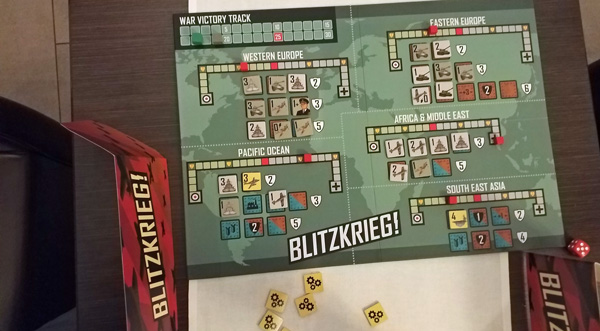
Playing Blitzkrieg! – the Axis player is two points ahead, but the Allies have the advantage in 3/4 of the remaining theatres
The rows of spaces in the different theatres represent separate campaigns and the player who's ahead in that theatre scores points when a campaign is completed. Of course, this means the player who's currently losing in that theatre has little incentive to complete it - unless they can swing things back their way. The end of the war is triggered when someone reaches 25 points and most points wins.
I'm impressed that the game lives up to its promise of completing the war in 20 minutes (or so), though it is set at a very abstract level. Blitzkrieg! provides a clever challenge as you try to out-guess your opponent, while being constrained by the tiles you have available. That's a provisional 8/10 on my highly subjective scale.
We were then joined by Sebastian Bleasdale, who was staying in the same hotel. Time for a new game and we broke out the latest from Bernd Eisenstein and Irongames, Pact. This is a card-drafting game of collecting goblins of different types so that you can complete 'task' cards with the right set of goblins. As this was our first game, we stuck to the beginners' game.
You start with the Spring tasks, four of which are available, along with a separate draft row of goblins plus your own hand of goblin cards. Your turn is either taking goblin cards or playing them. There's no hand limit, so you can take as many goblins as you want. Except that if the deck runs out, everybody must discard down to five cards. Oops! A large hand does give you more choice, but you can't play more than three cards on your turn.
Whether you've played or drawn cards, you can then complete a task, if the right set of goblins is available. Now, it's unlikely that you'll be able to play enough goblins in one turn to complete a task, so you'll have to leave them on the table for later. However, any player can use the goblins in front of one of their neighbours to complete a task. This shares the points for the task between the players, rather than one player taking them all.
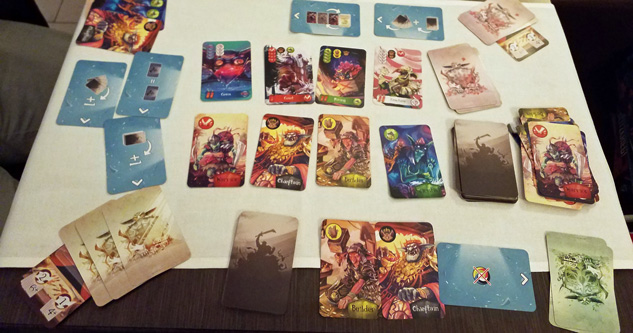
Here's my position in our game of Pact – bottom left are my joint contracts with Sebastian
This means you have to put some thought into which goblins you leave in front of you. When completing a task with a neighbour, it makes good sense to use as many of their cards and as few of yours as possible. Hence you want to put down cards that one of your neighbours may find useful, while not letting them have too many.
On top of this, there are some bonus cards which are shared out at the beginning. When a player uses one, they pass it on, so all the bonuses should be available to you at some point (unless you're playing with Sebastian, who kept hogging them for some undisclosed - tactical? - reason). On first acquaintance, it seems quite a slight game, though there can be some neat tactical options. It gets a provisional 7/10 on my highly subjective scale.
If it's that crowded, it must be Saturday
Saturday at Spiel usually means shuffling painfully slowly along the aisles, bumping into the person in front when they suddenly stop to look at something. Plus being buffeted by those wearing huge backpacks. Yes, it's crowded. Very crowded. Despite the risks, Peter and I hit the popular hall 3.
Our first stop was Lautapelit, where we got to try Amul (designed by Remo Conzadori and Stefano Negro) with an entertaining Dutch gamer. This is a card-drafting, set-collecting game set around an Arabian market. It will apparently take up to eight players, each additional player not only adding extra cards to the deck, but adding different types of cards, opening up new tactical possibilities.
The drafting mechanism is interesting. Players choose a card each and these go into the market with a card off the deck (with three players) before being turned up. Then players take a card from the market. Hence it is possible to get your own card back, but you can't rely on doing this (unless you're first player that round). The other thing to note is that this doesn't change your hand very much.
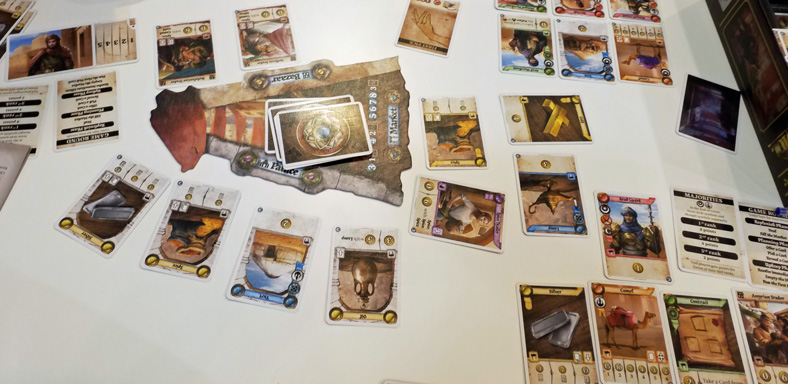
Amul in play: the market is right of centre, between players' tableaux, and we're on round 5 (indicated top left)
After this, players choose another card which, when revealed, stays on the table in front of them. Unless it only has a hand icon on it: these cards only score if they're in your hand at the end and just get thrown away if they're on the table. As you'd expect, the game's complexity is all in the cards and their interactions. What you're looking for, of course, are combinations that will score lots of points. And you don't have long to do it as the game is played over just nine rounds.
There's a definite learning curve in getting to grips with what all the cards do. Luckily, it's an entertaining and appealing game to play and I can see it being popular. This is another one that I'm looking forward to playing some more - especially with different numbers of players. Having played it sveeral times since Spiel, Amul gets 9/10 on my highly subjective scale.
Our next stop was at Stronghold Games, who produce the US version of Amul. However, we had a go at Potemkin Empire (published under the Indie Boards & Cards brand) with designer Jonathan Woodard on demo duty. The game reflects the historical incident when fake villages were erected to impress Catherine the Great as she progressed along the Dnieper river on a visit to the Crimea.
The game is card driven and participants can just play one from their hand - if it has an event on it. However, it's more fun to take one of the cardboard building façades and add it to your row. A face-down card goes behind the façade to identify it as real or fake, but only you know. Of course, fake buildings are worth points at the end of the game, not real ones!
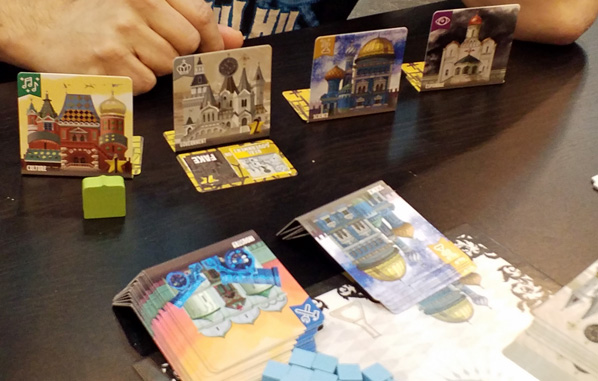
We've spotted one fake in this Potemkin village – what about the rest?
Whether they're real or fake, the different types of building provide actions for players - producing income, say, which is also worth points. The most important of these actions is sending a spy to challenge another player's building. Identify a fake and you get a reward, but if the building's real there's a penalty. The game lasts four rounds, after which the building cards are revealed and outrageous bluffing rewarded. Potemkin Empire was good fun, even with just three players, so I'd like to try it with more. For the time being it gets a provisional 7/10 on my highly subjective scale.
Strolling past Belgian publisher Sit Down! stand, we were enticed to try Wormlord by co-designer Jonathan Bittner, who was refereeing each game. This is a good move as the game is a frantic, real-time scramble to deploy your army of worms to take control of the towers depicted on the board tiles!
When I say worms, I mean short, fat shoelaces. To deploy one, you tie a loose knot and drop it on a square next to another of yours (or your start position). If an enemy worm is there, you untie it and chuck give it back. At first you think the game will take forever as players swap ownership of the towers. And then somebody sneaks a win! Wormlord is utterly hilarious and really does take about 10 minutes to play. It went down well at MidCon in November and and at Swiggers games club and gets 9/10 on my highly subjective scale.
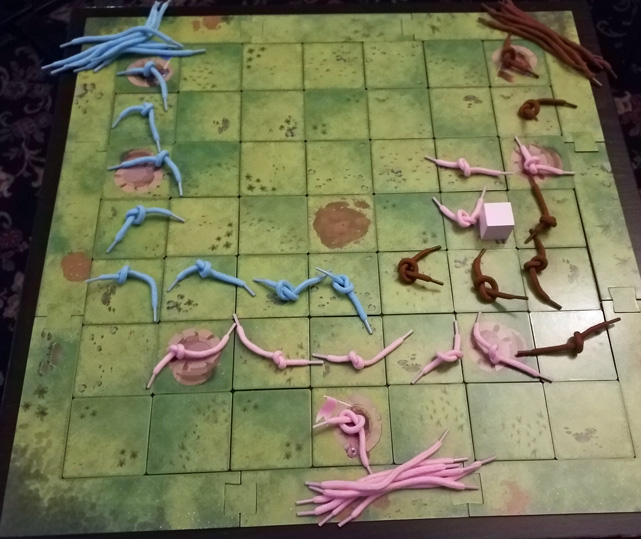
Wormlord on display – the block marks a starting position and pink has three castles despite being cut in half
Peter and I needed something quieter after this and tried out De Stijl, whose Mondrian-style artwork attracted our attention. It was designed by Lucas Gerlach and is published by Quick Simple Fun Games, a new name to me. It's played with large square cards printed with blocks of four different colours (plus white) in a notional square grid, separated and divided by black lines.
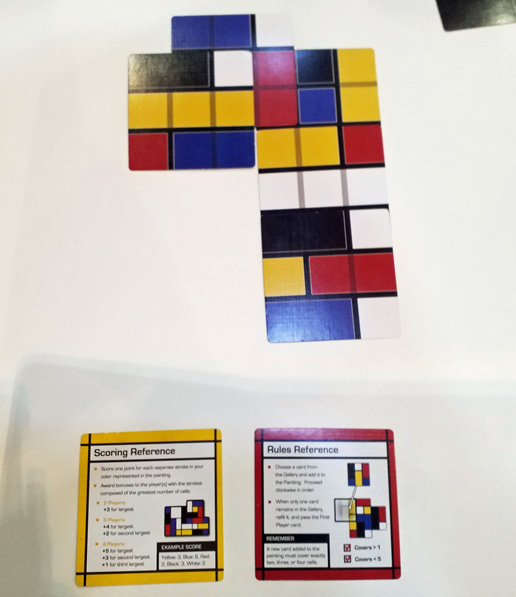
Starting our game of De Stijl – could it look more Mondrian-like?
Players simply take a card and add it to those on the table. The new card must overlap some squares of the cards already on the table, but not too many. Once the cards run out, players score the areas in their colour with a (substantial) bonus for the largest area.
The way the game plays, you can't help but add areas for your opponents as well as yourself. You just hope to come out on top - there didn't seem to be too much control, even in a two-player game (we scored for two colours each, by the way). There was a lot of thinking, but I'm not sure whether it made much difference. De Stijl is definitely not my thing and gets a provisional 4/10 on my highly subjective scale.
As we had discovered the day before, Game Brewer had a bar on their stand serving some excellent Belgian beer (well, that is where they come from). After a refreshing Tripel (a mere 7% alcohol-by-volume), we grabbed the opportunity to play Dawn of Mankind. Designed by Marco Pranzo (the man behind the terrific Historia), this is published by Tasty Minstrel Games, sharing the stand with Game Brewer.
The idea is that you are growing and improving your prehistoric tribe - the meeples portray a stereotypical 'caveman' carrying a large club! It's a kind of worker placement game. Tiles in columns across the board provide actions, but you then have to wait for your meeples to be bumped on before you can move them to another space. This means you sometimes have no alternative but to take a whole turn to get them back in play.
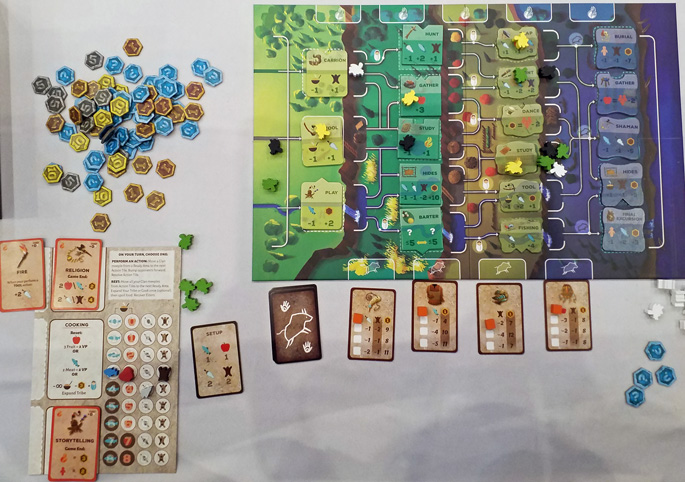
Look at those cavemen go! From babies at the left of the board to elders at the right
Some actions provide resources. Others let you spend resources to enhance your tribe (bonus resources, higher points scoring and so on). However, the routes between action spaces are limited, so you need to plan where you want a particular meeple to go as it progresses across the board (and eventually 'dies' and goes back into stock). A key element, of course, is getting more meeples into play. I thoroughly enjoyed this clever little game, despite being comprehensively beaten by the German couple playing with Peter and me. Mind you, they had played the game once already. That's 9/10 for Dawn of Mankind on my highly subjective scale as I've played it quite a few times since Spiel.
Strolling back into hall 3, we found a table at Quined Games to try something more heavyweight: Chicago 1875: City of the Big Shoulders. Even the name is heavyweight. And the designer is Raymond Chandler III. No, really. With an American gamer as third player, we worked through a couple of rounds (there are only five in a full game) using a demo set-up - which, we were warned, avoided the more cut-throat elements of the game.
The theme is businesses in several Chicago industries (I immediately think "meat-packing"). However, players are not necessarily business owners. In 18xx style, they buy and sell shareholdings in various companies and it's the Director (majority shareholder) who operates the company. As in 18xx games, there is a separation between players' money and companies' cash, with the companies (hopefully) paying dividends to share-holding players.
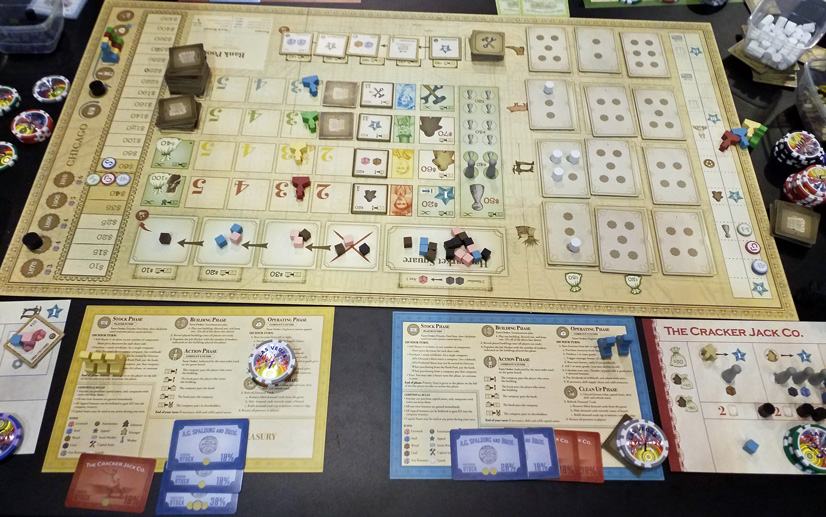
I'm running The Cracker Jack Co with lots of workers (until I automate them out of jobs!), but playing blue
Running a company involves adding buildings, taking actions (such as hiring workers or automating processes), manufacturing the company's products and, finally, selling them to generate the company's revenue. This can then be paid out as a dividend, putting money in shareholders' pockets and raising the company's share price. Or revenue can be retained to provide investment funds at the cost of reducing the share price.
I was very taken with this game. For a start, it's great to see a game that deals with proper industrial businesses. This would be complex enough on its own, but the addition of share-dealing, with the scope this adds for manipulation, takes the game to a different level. I can't wait to play it properly and it's my favourite heavyweight from this year's Spiel. That's a provisional 9/10 on my highly subjective scale.
Peter and I found a terrific little Italian restaurant for dinner - it's essentially someone's front room with a small bar at the back of the room and a kitchen to the rear. I reckon you could just squeeze in 26 diners. We realised the food would be good when we noticed that the group occupying the large table when we arrived were Italian! And indeed it was.
Returning to the hotel, Peter and I tried out the copy of Bushido that the nice people at Grey Fox Games had pressed on me. Designed by Pedro Mendoza, this is a two-player game of samurai-themed duelling. Unfortunately, neither of those two things appeals much to me. It's essentially a card game, with cardboard chips to represent what players accumulate during a fight and player boards to lay things out on.
We tried the training game first. This goes straight to the duelling rules so that you can get to grips with how this works first. Unfortunately, this means you skip a couple of important rules sections that make a big difference in understanding the game. During the duel, you play a card for the attack you're making. This, together with your weapon and current 'guard' give you a number of dice to roll - the different types of dice give you varying probabilities of hits, armour and dodging.
The hits go against your opponent, while the defensive results let you counter hits doled out in your opponent's last turn. This is rather clever: it gives you the opportunity to react to your opponent's attack in your turn. One other thing to note: you only pick up your attack cards by changing 'guard', which gives the initiative to your opponent. The mixture of different weapons and the initial phase of drafting your attack cards suggests this is a game of some subtlety.
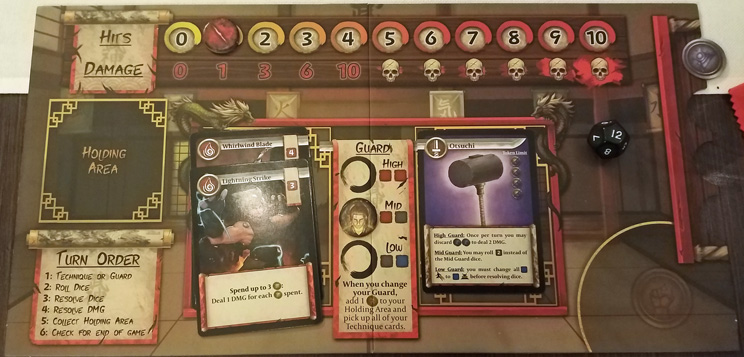
Our full game of Bushido: I have my big hammer in middle guard, trying to stave off the hit Peter has inflicted
Peter's and my training game saw him take me out in short order. Switching to the full game, which is still pretty straightforward, saw a much longer fight where we both had a much better idea what we were doing. I eventually prevailed with a simple strategy: hit 'im wiv a large 'ammer! Despite the good things about this, it's so much not my kind of game that I can't see me playing it often. Bushido gets a provisional 6/10 on my highly subjective scale.
We finished off our Saturday evening with a couple more games of Blitzkrieg!, proving that I can beat Peter both as Allies (who have the advantage of winning a tie) and Axis. Peter's strategy as the Axis of bombing me into submission didn't work and I didn't try it when it was my turn to be the guys in grey. This was definitely my most-played game of Spiel '19.
Saving the best (?) 'til last (Sunday)
Checking out of the hotel meant a leisurely start to the last day of Spiel '19. Sunday is a bit quieter than Saturday, anyway. Our initial stroll took us into corners we hadn't visited before and Peter picked up a copy of Clans of Caledonia (and some goodies) from the nice guys at Karma Games.
Our peregrination took us to Devir where I suggested having a go at Paris: La Cité de la Lumière (which I translate as "Paris: City of Light"). Yes, another two-player game! Designed by Jose Antonio Abascal Acebo, it's also a game of two halves. First you place square tiles of cobblestones into the box - I do like a game that's played in the box. The tiles are divided into squares of one or both players' colours and many also have a neutral square with a streetlight. As an alternative action, you can reserve one of the polyomino building tiles.
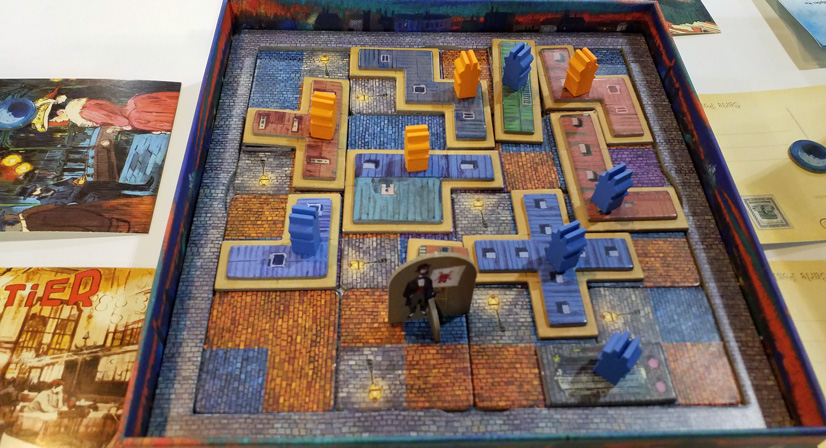
It's almost over, with blue's mini-extension (behind the artist) proving crucial
Once all the cobbles have been laid, the second half is placing your reserved building tiles onto cobbled areas of your/both colours, marking ownership with a 'chimney' in your colour and avoiding the streetlights. Having set up a block of cobbles to fit one of your large buildings, it's so annoying when your opponent plonks one of his buildings into it! The crucial thing is that buildings need to be illuminated by (next to) streetlights to score. There's also a bonus for the biggest contiguous group - which made a big difference in our game.
Now, this is a two-player game that's pretty abstract. It shouldn't appeal to me, yet it does. Possibly it's the subject matter or the evocative artwork, but I did enjoy it and give Paris: La Cité de la Lumière a provisional 7/10 on my highly subjective scale.
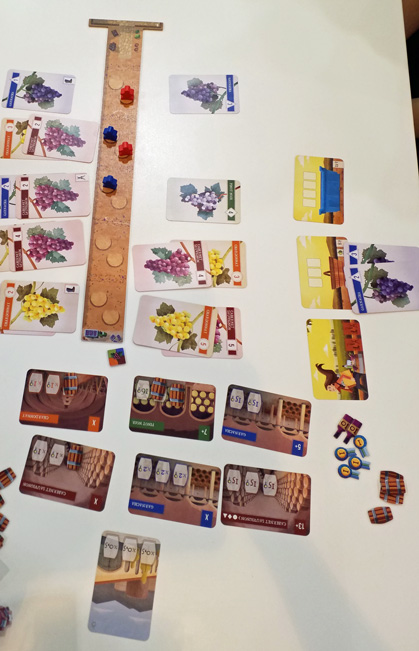
You get two pickers in a two-player game, here trying to box clever as they progress
While we were with Devir, we thought we'd give La Viña a go. This one was designed by Jose Ramón Palacios and is essentially a card game. However, there is a central track, along which players advance their grape-picking pawns. In time-honoured fashion, your pawn (two each in a two-player game) can move forward as far as you like, but can't come back. It's then the turn of the pawn at the back, possibly allowing a player multiple turns in a row. Wherever your pawn lands, you pick up an adjacent grape card and add it to one of your baskets.
The aim is to pick the right grape varieties in the right values to meet (at least) the minimum requirements of the objective cards at the end of the track. These score points, of course, and are then covered by a barrel tile, making the next objective available. It's not that simple of course - right the way through the game there are limitations on what you can do (though I'm not sure these were explained correctly) that make the game trickier. In addition, some grape cards show tools. Taking one of these cards gives you the appropriate tool, which you can use to break the rules in some way. On first acquaintance, La Viña is a nice enough lightweight game. That's a provisional 6/10 on my highly subjective scale.
After this and a bite of lunch (these days visitors to Spiel don't have to rely on the Messe's concession stands, there are half a dozen clumps of food wagons about the place, providing all sorts of interesting cuisine), we strolled over to hall 5 to see a game that had been recommended to me, Yin Yang from Taiwanese publisher BGNations and designed by DuGuWei. This involves each player tossing half a dozen Chinese coins each turn (or possibly using the turtle shell provided to shake them). These give black/white (or heads/tails) combinations that you use in different ways, starting with an immediate action.
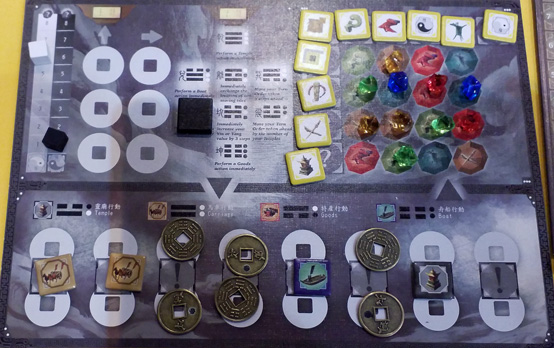
My player board showing the actions I've programmed with my coins and tiles
However, the key use of the coins is in pairs as your actions for the turn ('programmed' in advance). As the game progresses, you'll pick up action tiles that provide a specific action each, so you get more and more actions as the game goes on. And much of what you're doing is travelling around the provinces on the board, collecting goods and building temples - one element of the scoring is area majority at the end.
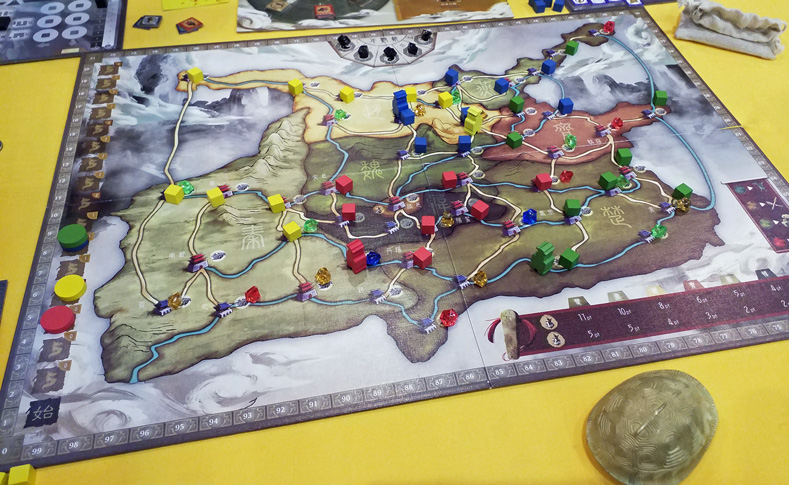
The main board at the end of our game - plus turtle shell
This is a cracker. There are plenty of options, lots of decisions and clearly different strategies. And the programming element is a nice challenge in getting the best out of the actions available to you each turn. Plus the clever use of a unique (?) component. That's a provisional 9/10 on my highly subjective scale. Now, where can I lay my hands on a copy?
A happy few hours playing Yin Yang brought my Spiel experience to an end this year. Time to retrace my journey and head home: U-bahn to the station, train to the airport and flight home. All nicely efficient and uneventful. A big thank you to Dominique Metzler and the rest of the organisers at Friedhelm Merz Verlag for another splendid four days. Next year's fair is scheduled for 22nd-25th October 2020 and I fully intend to be there. For more information, see the website: www.spiel-messe.com/en (for the English language version).
All trademarks acknowledged. Game artwork courtesy of the publisher.
Photos were taken by Pevans, who played with Photoshop.
A shorter version of this report was published in To Win Just Once issues 199 and 200 (November and December 2019).

